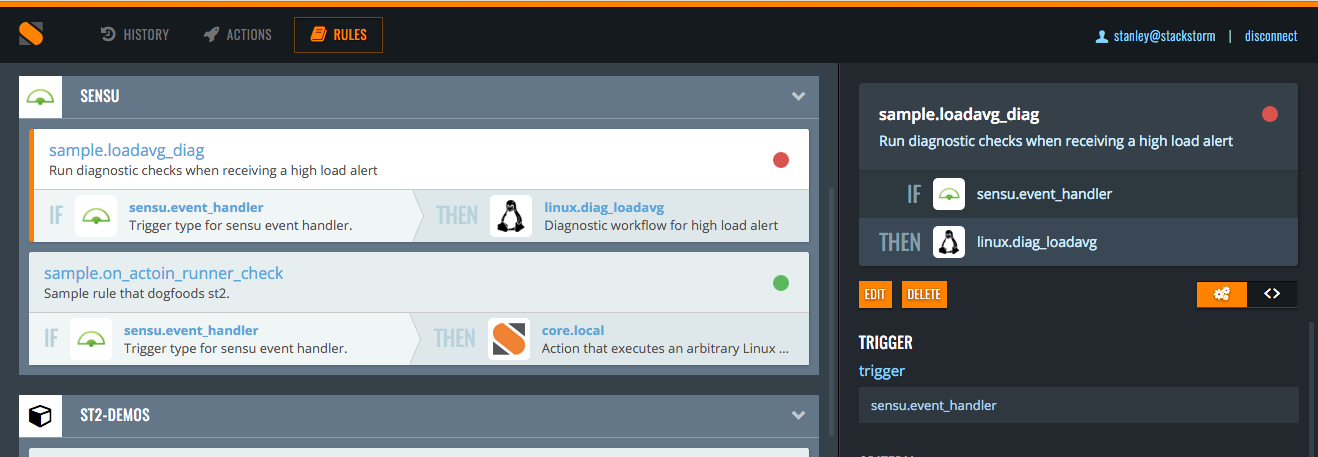November 02, 2015
by Dmitri Zimnie

A new release of StackStorm is out…. and (…drums…) it is version 1.1!
Yes, this is a major release. The product has really come together, so we decided to name it “version 1”. In his recent Hello World blog Evan Powell shared the learnings over two years that become foundation of StackStorm and made it a distinct product. Here I will go over specific feature highlights of version 1, touch on migration path from earlier versions, and point out to StackStorm’s future directions.
Version 1 comes in two editions – Community and Enterprise. They share a common codebase; “Community” is full-featured, production-ready, Apache 2.0, and free forever. “Enterprise” brings commercial support and additional tools to improve productivity at scale.
StackStorm v1 introduces a few new exciting features as well as accumulated improvements based on your feedback and extensive field usage. For the complete list, see Changelog.
Behind the All-In-One installer, there are puppet modules to use directly for your custom deployments, and st2workroom to build StackStorm into a variety of form-factors. In addition to Ubuntu 14, we introduce support to RHEL 6 and 7.
Flow v1 – an innovative visual workflow designer. Flow is unique: unlike every other workflow designer, Flow doesn’t hide the code: it highlights it as part of our support for infrastructure as code. It helps you navigate, understand, and learn the workflow definition YAML with appealing visual representation, and makes you more productive building workflow structure with drag-and-drop WYSWIG functionality. It is worth giving a try on your side; it is also worth a dedicated blog on us (coming up).
Security: RBAC and StackStorm-supported LDAP integration are essential enterprise features. There is more: pluggable auth backends with solid PAM, Keystone and other auth providers; ‘Secrets’ in metadata, which prevent flashing parameters in logs and API; and API keys, especially handy for webhooks.
ChatOps: with StackStorm, ChatOps is turn-key, much improved and maturing based on massive feedback from the community. Even those still cautious about closed loop automation and auto-remediation find it very appealing to be able to take their existing scripts, plus StackStorm community actions including Ansible, Salt, Chef or Puppet integrations, turn them at will into bot-friendly ChatOps commands with few lines of meta data. These ChatOps users then get the workflows, APIs, execution history and everything else of StackStorm as a bonus – we see them growing over time into more powerful users.
The recommended way to migrate to v1 is to provision a new StackStorm instance with All-In-One installer, and to roll over the content. Copy your content from /opt/stackstorm/packs to the new v1 server. If you’re doing it right, your content should already be under source control. Adjust content according to upgrade notes. Test, make sure everything works. To keep your previous history for audit purpose, save the /var/log/st2/*.audit.* files.
The old scripted installer aka st2_deploy.sh is still supported, and it will likely get you upgraded. However we seriously encourage you to switch to the all-in-one installer. Or for serious production, puppet, chef, or ansible yourself a custom deployment of v1.
StackStorm continues to rapidly evolve. Our next focus is around productizing techniques to runat scale, refining content management, debuggability of sensors and triggers, completing the mission of making StackStorm easy to deploy. We are thinking of introducing StackStorm Forge to get together even more of the hundreds of integration packs spread all over github. We want to help the community share and exchange operational patterns as code blueprints. The detailed roadmap is here, and your input is welcome.
Get v1, install, use, enjoy. Take the Flow for a ride. Give us feedback. And stay engaged on stackstorm-community.slack.com (if you’re not there yet, join), or IRC #stackstorm on freenode.org.